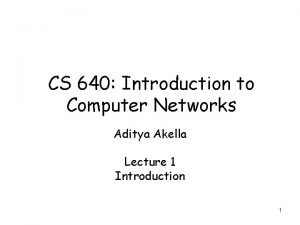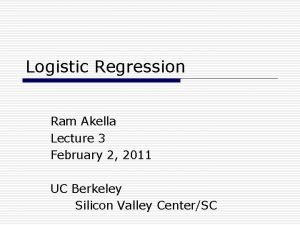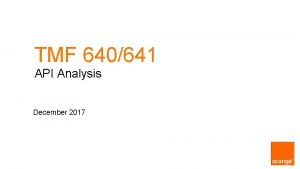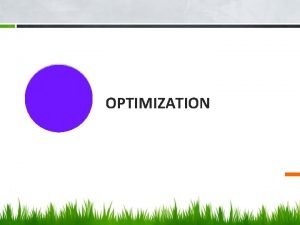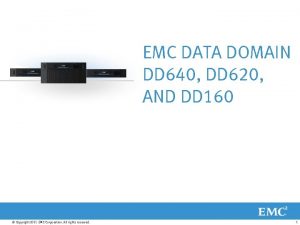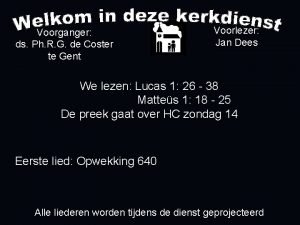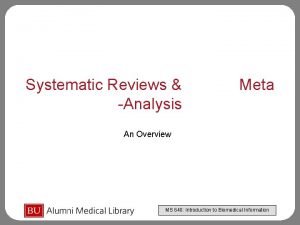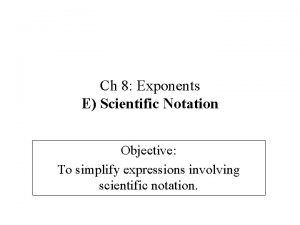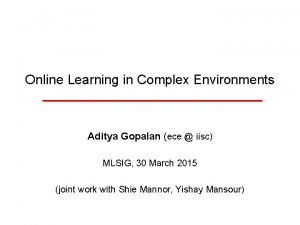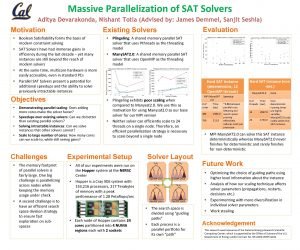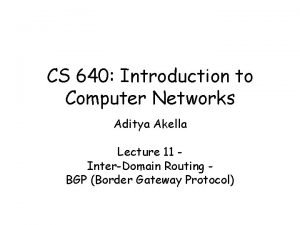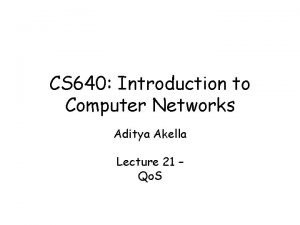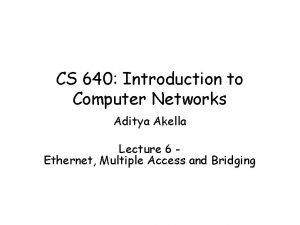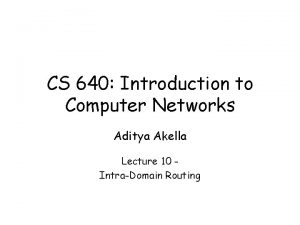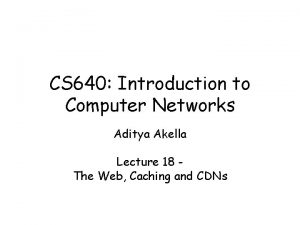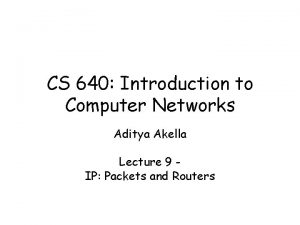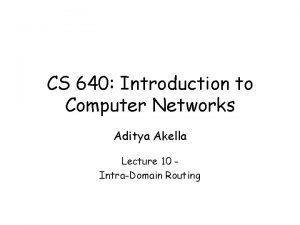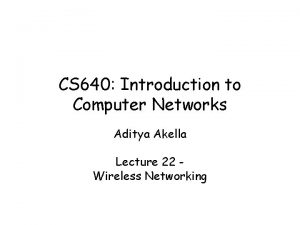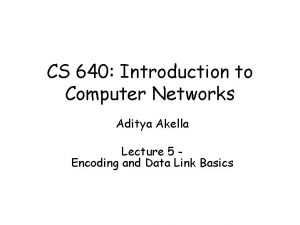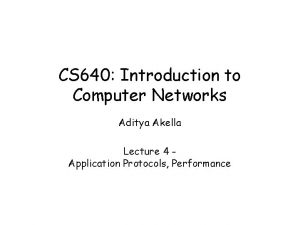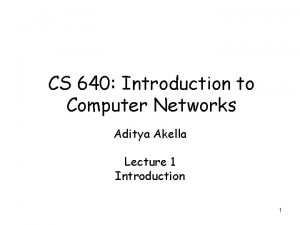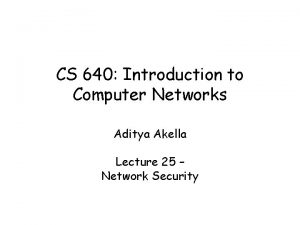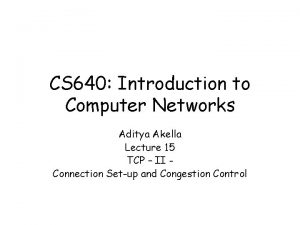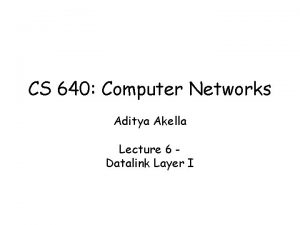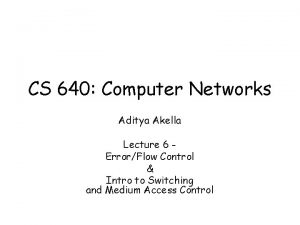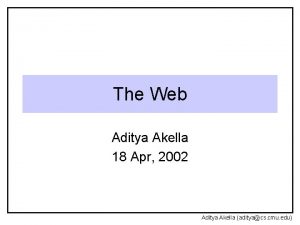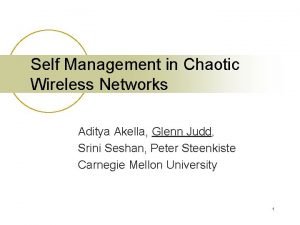CS 640 Introduction to Computer Networks Aditya Akella




































- Slides: 36

CS 640: Introduction to Computer Networks Aditya Akella Lecture 11 Inter-Domain Routing BGP (Border Gateway Protocol)

Intra-domain routing • The Story So Far… – Routing protocols generate the forwarding table – Two styles: distance vector, link state – Scalability issues: • Distance vector protocols suffer from count-to-infinity • Link state protocols must flood information through network • Today’s lecture – How to make routing protocols support large networks – How to make routing protocols support business policies 2

Inter-domain Routing: Hierarchy • “Flat” routing not suited for the Internet – Doesn’t scale with network size • Storage Each node cannot be expected to store routes to every destination (or destination network) • Convergence times increase • Communication Total message count increases – Administrative autonomy • Each internetwork may want to run its network independently – E. g hide topology information from competitors • Solution: Hierarchy via autonomous systems 3

Internet’s Hierarchy • What is an Autonomous System (AS)? – A set of routers under a single technical administration • Use an interior gateway protocol (IGP) and common metrics to route packets within the AS • Connect to other ASes using gateway routers • Use an exterior gateway protocol (EGP) to route packets to other AS’s – IGP: OSPF, RIP (last class) – Today’s EGP: BGP version 4 4

An example 2 c 3 b 3 a 3 c 2 a AS 3 AS 2 1 c 2 b 1 b 1 a AS 1 1 d Intra-AS routing algorithm + Inter-AS routing algorithm Forwarding table 5

The Problem • Easy when only one link leading to outside AS • Much harder when two or more links to outside ASes – Which destinations reachable via a neighbor? – Propagate this information to other internal routers – Select a “good route” from multiple choices – Inter-AS routing protocol • Communication between distinct ASes • Must be the same protocol! 6

History • Mid-80 s: EGP – Reachability protocol (no shortest path) – Did not accommodate cycles (tree topology) – Evolved when all networks connected to NSF backbone • Result: BGP introduced as routing protocol – Latest version = BGP 4 – BGP-4 supports CIDR – Primary objective: connectivity not performance 7

BGP Preliminaries • Pairs of routers exchange routing info over TCP connections (port 179) – One TCP connection for every pair of neighboring gateway routers – Routers called “BGP peers” – BGP peers exchange routing info as messages – TCP connection + messages BGP session • Neighbor ASes exchange info on which CIDR prefixes are reachable via them 8

Choices for Routing • How to propagate routing information? • Link state or distance vector? – No universal metric – policy decisions – Problems with distance-vector: • Very slow convergence – Problems with link state: • Metric used by ISPs not the same loops • LS database too large – entire Internet • BGP: Path vector 9

AS Numbers (ASNs) ASNs are 16 bit values 64512 through 65535 are “private” Currently over 15, 000 in use • • Genuity: 1 MIT: 3 CMU: 9 UC San Diego: 7377 AT&T: 7018, 6341, 5074, … UUNET: 701, 702, 284, 12199, … Sprint: 1239, 1240, 6211, 6242, … … ASNs represent units of routing policy 10

Distance Vector with Path • Each routing update carries the entire ASlevel path so far – “AS_Path attribute” • Loops are detected as follows: – When AS gets route, check if AS already in path • If yes, reject route • If no, add self and (possibly) advertise route further – Advertisement depends on metrics/cost/preference etc. • Advantage: – Metrics are local - AS chooses path, protocol ensures no loops 11

Hop-by-hop Model • BGP advertises to neighbors only those routes that it uses – Consistent with the hop-by-hop Internet paradigm – Consequence: hear only one route from neighbor • (although neighbor may have chosen this from a large set of choices) • Could impact view into availability of paths 12

Policy with BGP • BGP provides capability for enforcing various policies • Policies are not part of BGP: they are provided to BGP as configuration information • Enforces policies by – Choosing appropriate paths from multiple alternatives – Controlling advertisement to other AS’s 13

Examples of BGP Policies • A multi-homed AS refuses to act as transit – Limit path advertisement • A multi-homed AS can become transit for some AS’s – Only advertise paths to some AS’s • An AS can favor or disfavor certain AS’s for traffic transit from itself 14

BGP Messages • Open – Announces AS ID – Determines hold timer – interval between keep_alive or update messages, zero interval implies no keep_alive • Keep_alive • Sent periodically (but before hold timer expires) to peers to ensure connectivity. • Sent in place of an UPDATE message • Notification • Used for error notification • TCP connection is closed immediately after notification 15

BGP UPDATE Message • List of withdrawn routes • Network layer reachability information – List of reachable prefixes • Path attributes – – – Origin Path Local_pref MED Metrics • All prefixes advertised in message have same path attributes 16

Path Selection Criteria • Attributes + external (policy) information • Examples: – Policy considerations • Preference for AS • Presence or absence of certain AS – Hop count – Path origin 17

LOCAL PREF • Local (within an AS) mechanism to provide relative priority among BGP exit points R 5 R 1 AS 200 R 2 AS 100 R 3 Local Pref = 500 AS 300 R 4 Local Pref =800 I-BGP AS 256 • Prefer routers announced by one AS over another or general preference over routes 18

AS_PATH • List of traversed AS’s AS 200 170. 10. 0. 0/16 AS 100 180. 10. 0. 0/16 AS 300 AS 500 180. 10. 0. 0/16 300 200 170. 10. 0. 0/16 300 200 19

Multi-Exit Discriminator (MED) • Hint to external neighbors about the preferred path into an AS – Different AS choose different scales • Used when two AS’s connect to each other in more than one place – More useful in a customer provider setting – Not honored in other settings • Will see later why 20

MED • Hint to R 1 to use R 3 over R 4 link • Cannot compare AS 40’s values to AS 30’s 180. 10. 0. 0 MED = 50 R 1 AS 10 R 3 180. 10. 0. 0 MED = 120 R 2 AS 40 180. 10. 0. 0 MED = 200 R 4 AS 30 21

MED • MED is typically used in provider/subscriber scenarios • It can lead to unfairness if used between ISP because it may force one ISP to carry more traffic: SF ISP 1 ISP 2 NY • ISP 1 ignores MED from ISP 2 • ISP 2 obeys MED from ISP 1 • ISP 2 ends up carrying traffic most of the way 22

Decision Process (First cut) • Rough processing order of attributes: – Select route with highest LOCAL-PREF – Select route with shortest AS-PATH – Apply MED (to routes learned from same neighbor) • How to set the attributes? – Especially local_pref? – Policies in action 23

A Logical View of the Internet • Tier 1 ISP Stub – “Default-free” with global reachability info • Tier 2 ISP – Regional or country-wide – Typically route through tier-1 Tier 3 Tier 2 • Customer • Tier 3/4 ISPs – Local – Route through higher tiers Tier 1 Tier 2 • Stub AS – End network such as IBM or UW-Madison 24

Inter-ISP Relationships: Transit vs. Peering Transit ($$ 1/2) Transit ($$$) ISP P ISP Y Transit ($) Transit ($$$) ISP Z Transit ($$$) Peering (0) Transit ($$) ISP X Transit ($$) These relationships have the greatest impact on BGP policies 25

Illustrating BGP Policies peer provider peer AS 4 customer Frank’s Internet Barn AS 3 AS 2 Which route should Frank pick to 13. 0. 0. /16? AS 1 13. 0. 0/16 26

Policy I: Prefer Customer routing Route learned from customer preferred over route learned from peer, preferred over route learned from provider peer AS 4 customer local pref = 80 local pref = 90 AS 3 local pref = 100 Set appropriate “local pref” to reflect preferences: Higher Local preference values are preferred AS 2 AS 1 13. 0. 0/16 27

Policy II: Import Routes provider route peer route From provider customer route ISP route From provider From peer From customer 28

Policy II: Export Routes provider route peer route To provider customer route ISP route From provider To peer To customer filters block 29

Policy II: Valley-Free Routes • “Valley-free” routing – Number links as (+1, 0, -1) for provider, peer and customer – In any valid path should only see sequence of +1, followed by at most one 0, followed by sequence of -1 – Why? • Consider the economics of the situation • How to make these choices? – Prefer-customer routing: LOCAL_PREF – Valley-free routes: control route advertisements (see previous slide) 30

BGP Route Selection Summary Highest Local Preference Enforce relationships E. g. prefer customer routes over peer routes Shortest ASPATH Lowest MED i-BGP < e-BGP traffic engineering Lowest IGP cost to BGP egress Lowest router ID Throw up hands and break ties 31

Internal vs. External BGP • BGP can be used by R 3 and R 4 to learn routes • How do R 1 and R 2 learn best routes? AS 1 R 3 E-BGP R 4 AS 2 R 2 • Use I-BGP • Create a full mesh • TCP connections • Use this to exchanged BGP route information 32

Link Failures • Two types of link failures: – Failure on an E-BGP link – Failure on an I-BGP Link • These failures are treated completely different in BGP • Why? 33

Failure on an E-BGP Link • If the link R 1 -R 2 goes down • The TCP connection breaks • BGP routes are removed • This is the desired behavior AS 1 R 1 E-BGP session R 2 AS 2 Physical link 138. 39. 1. 1/30 138. 39. 1. 2/30 34

Failure on an I-BGP Link • If link R 1 -R 2 goes down, R 1 and R 2 should still be able to exchange traffic • The indirect path through R 3 must be used • Thus, E-BGP and I-BGP must use different conventions with respect to TCP endpoints 138. 39. 1. 2/30 R 2 Physical link 138. 39. 1. 1/30 R 1 R 3 I-BGP connection 35

Next Class • Multicast – – Service model IGMP IP Multicast routing protocols Overlay-based multicast 36
 Uw madison cs 640
Uw madison cs 640 Datagram switching vs virtual circuit switching
Datagram switching vs virtual circuit switching Basestore iptv
Basestore iptv Ram akella
Ram akella Divya akella
Divya akella Tmf641
Tmf641 Ccna 640
Ccna 640 We need to enclose a field with a fence. we have 500 feet
We need to enclose a field with a fence. we have 500 feet Emc dd640
Emc dd640 Heptarchy
Heptarchy Log 640
Log 640 Ccna voice 640-461 pdf
Ccna voice 640-461 pdf Opwekking 640
Opwekking 640 Whole numbers chart
Whole numbers chart 390 en yakın onluğa yuvarlama
390 en yakın onluğa yuvarlama Hino 640
Hino 640 Ms 640
Ms 640 Ccna 640-802
Ccna 640-802 640 000 in scientific notation
640 000 in scientific notation A 640 n hunter gets a rope
A 640 n hunter gets a rope 01:640:244 lecture notes - lecture 15: plat, idah, farad
01:640:244 lecture notes - lecture 15: plat, idah, farad Aditya yadravkar
Aditya yadravkar Aditya gopalan
Aditya gopalan Apana vayu mudra benefits
Apana vayu mudra benefits Aditya parameswaran
Aditya parameswaran Bogi aditya
Bogi aditya Aditya birla nuvo health insurance
Aditya birla nuvo health insurance Moses charikar
Moses charikar Petrolera zuata
Petrolera zuata Foundations of software testing aditya p mathur pdf
Foundations of software testing aditya p mathur pdf Aditya nori
Aditya nori Aditya devurkar
Aditya devurkar Aditya khosla
Aditya khosla Deepfix: fixing common c language errors by deep learning
Deepfix: fixing common c language errors by deep learning Nyoman bogi aditya karna
Nyoman bogi aditya karna Aditya devarakonda
Aditya devarakonda Ciri ciri kelompok primer dan sekunder
Ciri ciri kelompok primer dan sekunder
